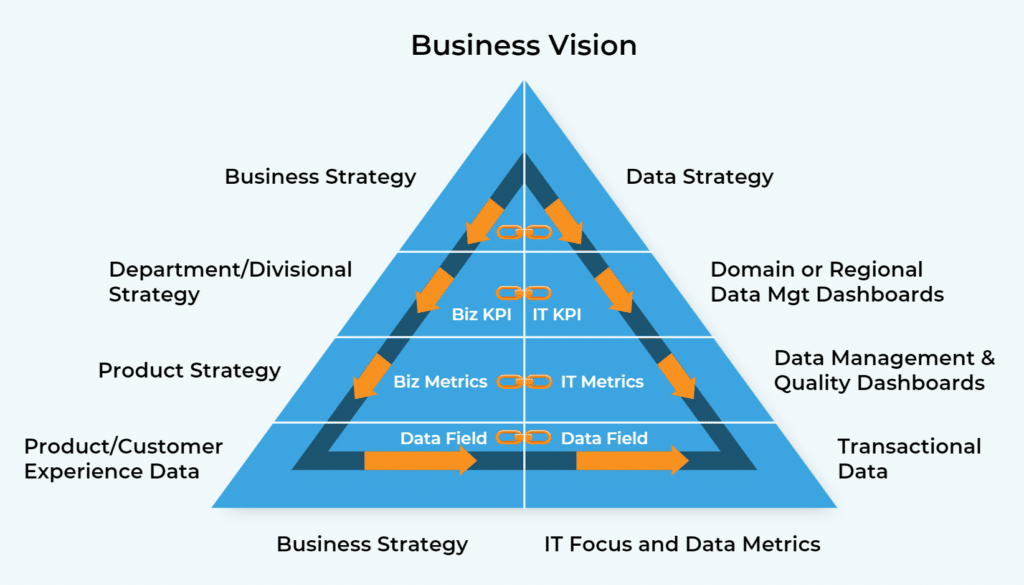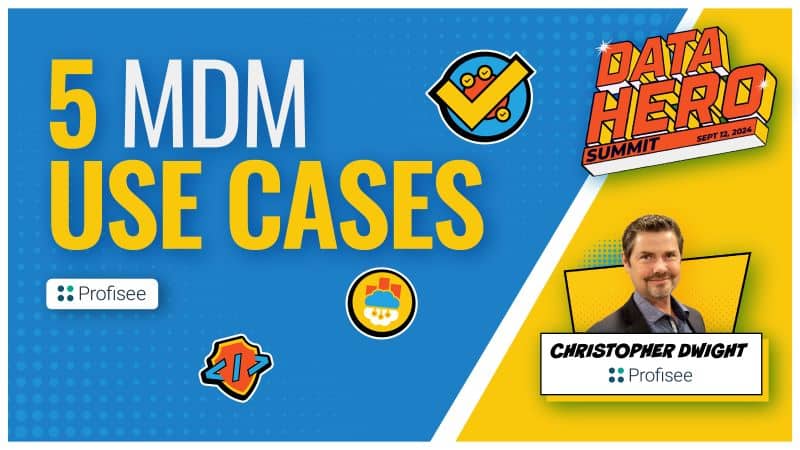Table of Contents
When creating your organization’s business strategy, there need to be high-level outcomes in place to guide the plan’s overall direction and momentum. This should also be reflected in your master data management (MDM) strategy. Your MDM strategy is unattainable if it exists in a vacuum!
Being high-level, these business outcomes do not require heavy detail as to how they are supported, but it does require an MDM strategy that connects your strategic vision with the operational tactics in an MDM roadmap. I know, it is easier said than done. The real question you should be asking is, “How do I seamlessly link my business vision and strategy with my MDM strategy and roadmap?”
Linking Your MDM Strategy with Quantifiable Metrics
Strategically linking your business plans with your MDM strategy require quantifiable metrics. Representing multiple levels of your enterprise, the connection is made through business key performance indicators (KPI). KPIs evaluate the success of an organization based on their varying levels of engagement. See Figure 1 for a better understanding of the long but limited list of possible business KPIs that are most likely already adopted and defined.
Figure 1: The Links Between Business Strategy and MDM Strategy Through Metrics

Although your MDM metrics will change and evolve, it’s important to evaluate how improving your approach to data management will impact your delivery on top KPIs within your organization. Don’t stress about the detailed specifics of these metrics because they will improve and require revisions later on, so give it time. However, they will set the foundation for your short-term outcomes, target goals and their respective business processes. This leads nicely to our next important factor.
Limiting the Scope of Your MDM Strategy
The best course of action is to limit your list of desired/supported outcomes. As tempting as it is to go wild and make a laundry list, it is far more important to build a link between your MDM strategy and business KPIs.
At first, it is okay to admit that you cannot support every one of your master data and business outcomes. The early stages of your MDM strategy require a deeper focus on a smaller handful of KPIs and outcomes (see Figure 2). This will ensure that your scope remains limited.
When defining your approach to MDM, keep your shortlist to roughly five to seven high-level business outcomes to include in your overall scope of the project. This comes from in-depth discussions with your program stakeholders throughout your enterprise.
Keep these discussions to a few weeks rather than months. MDM mandates have deadlines, so don’t spend too much time talking about the logistics.
Figure 2: The Most Viable Product (MVP) Approach to Implementing an MDM Strategy
That being said, ask them about what you are unable to accomplish due to your data’s current limitations and which of these are holding you back from their top two or three business priorities. This will provide you with potential outcomes to include within your strategy’s limited scope. Then you can link each outcome to a certain number of KPIs.
Creating your short-term strategy will help you develop your three- to -five-year strategy. Treat MDM like a journey, not a short walk around the neighborhood. There are multiple use cases and stakeholders involved, so your roadmap must deliver increased revenue while decreasing cost and reducing risk.
Do not boil the ocean when it comes to determining your scope. It’s important to remain optimistic but also realistic.
Developing an Estimate Roadmap for Your MDM Strategy
As mentioned before, working with your stakeholders is crucial in developing higher-level estimates concerning the influence that enhancing your master data quality has on your target KPIs.
It is necessary for evaluating your scope in the early phases of an MDM implementation. Having a roadmap when starting out helps you keep the course and remain focused without trying to do too much.
Rather than creating net new business KPIs, focus on the ones currently measuring your business performance. Data leaders need to have a swift turnaround with their MDM initiatives, especially in the early stages when leaving an impression on their stakeholders and leadership is key. Prioritize your outcomes and KPIs based on how the business defines them.
You want to have rough measurements that show how MDM and improving your data deliver significant value for your business. However, this also means balancing this with a limited scope to increase your success rate. Your estimate roadmap doesn’t need to be perfect! These are rough estimates to help you prioritize, not an accurate blueprint.
DATA INSIGHTS,
DIRECT TO YOUR INBOX
Managing MDM Strategy Priorities, Not Domains
When it comes to developing your strategy’s scope, priorities must remain associated with your business KPIs and outcomes, not domains. It is a common mistake to build your MDM program around domains with two big ones being “customer” and “product.” If your stakeholders are not measuring your organization’s success with domains serving as a metric, neither should you.
Although your KPIs may certainly cross multiple domains, they need to remain secondary in your strategic approach. A huge benefit to quantifying your MDM success is optimizing consultant relationships. Knowing your top desired outcomes will provide consultants with an SOW focused on a specific deliverable. This then improves to manage and budget any consultant hired to support your implementation.
With KPIs and outcomes, you have a tighter, more easily manageable approach. Domains only take more time and money than anticipated while delivering a scope that seems out of reach. Avoid domains at all costs, literally.
Read the Full Guide on the Key Attributes of a Modern MDM Strategy
Adopting a modern MDM strategy for your business requires expert insights on what drives growth and success while understanding the common pitfalls that have previously held back so many others from their strategic initiatives.
Read the complete guide for a full breakdown of the six key attributes of a modern MDM strategy and learn how you can finally overcome the data-quality issues keeping you from achieving your business goals.
Malcolm Hawker
Head of Data Strategy @ Profisee
MAKE IT EASY WITH SIMPLIFIED MDM

Malcolm Hawker
Malcolm Hawker is a former Gartner analyst and the Chief Data Officer at Profisee. Follow him on LinkedIn.
















